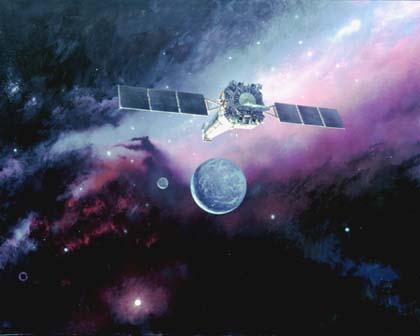THE CHANDRA X-RAY OBSERVATORY CENTER
The Chandra X-Ray Observatory, launched on July 23, 1999, has taken its place with the Hubble Space Telescope and Compton Gamma Ray Observatory in NASA's fleet of Great Observatories. As the world's premier X-ray observatory, Chandra gives astronomers a powerful new tool to investigate the hot regions of the universe where black holes, exploding stars, and colliding galaxies hold sway.
The Chandra X-Ray Observatory Center
The Chandra program, managed by NASA's Marshall Space Flight Center
in Huntsville, Alabama, is an example of NASA's initiative to
streamline the operations of its space science missions. The
Smithsonian Astrophysical Observatory's Chandra X-Ray Center (CXC),
under the direction of Dr.Harvey Tananbaum, is located at the
Harvard-Smithsonian Center for Astrophysics in Cambridge
Massachusetts.
The CXC is responsible for planning the science observations based on proposals from the scientific community, processing data received from the observatory, and providing technical and scientific support to the scientists who use Chandra. The Center operates the observatory from its Operations & Control facility located at One Hampshire Street in Cambridge, Massachusetts.
The CXC is a collaboration of personnel from the Smithsonian Astrophysical Observatory, the Massachusetts Institute of Technology (MIT), and the Chandra prime contractor, TRW (now NGST).
 Communication between the Chandra Observatory and the Chandra Operations and Control Center is via the deep space network.
Communication between the Chandra Observatory and the Chandra Operations and Control Center is via the deep space network.The Operations & Control Center (OCC) is staffed by the CXC, with the Flight Operations Team provided by TRW (now NGST). The OCC has a glass-walled area outside the main control room where visitors and press can watch the Flight Operations Team and mission specialists as they communicate with the observatory and carry out the space flight operations.
Commands for executing the observation plan are transmitted from the OCC to one of three ground stations (in Spain, Australia, or California) that make up NASA's Deep Space Network (DSN). The DSN relays the commands to the orbiting spacecraft. The spacecraft carries out the commands and points the telescope to the specified targets, and moves the science instruments to their appropriate positions.
 Map of the Deep Space Network, showing locations of radio telescopes in California, Spain, and Australia.
Map of the Deep Space Network, showing locations of radio telescopes in California, Spain, and Australia.During routine operations, science data and monitoring data will be sent from the spacecraft to the OCC, via the DSN, approximately every eight hours. Scientists and engineers will use monitoring data to assess Chandra's condition. If the health or safety of the observatory appears to be in danger, the operating mode and the observation plans will be modified.
Data from Chandra observations are processed at the Chandra Center. Observatory calibration data will be made public as soon as possible. The scientific data belonging to guest observers and guaranteed time observers can be held by them for one year to allow time for analysis and publication of scientific results. The data are then placed in the public archive.
Top




